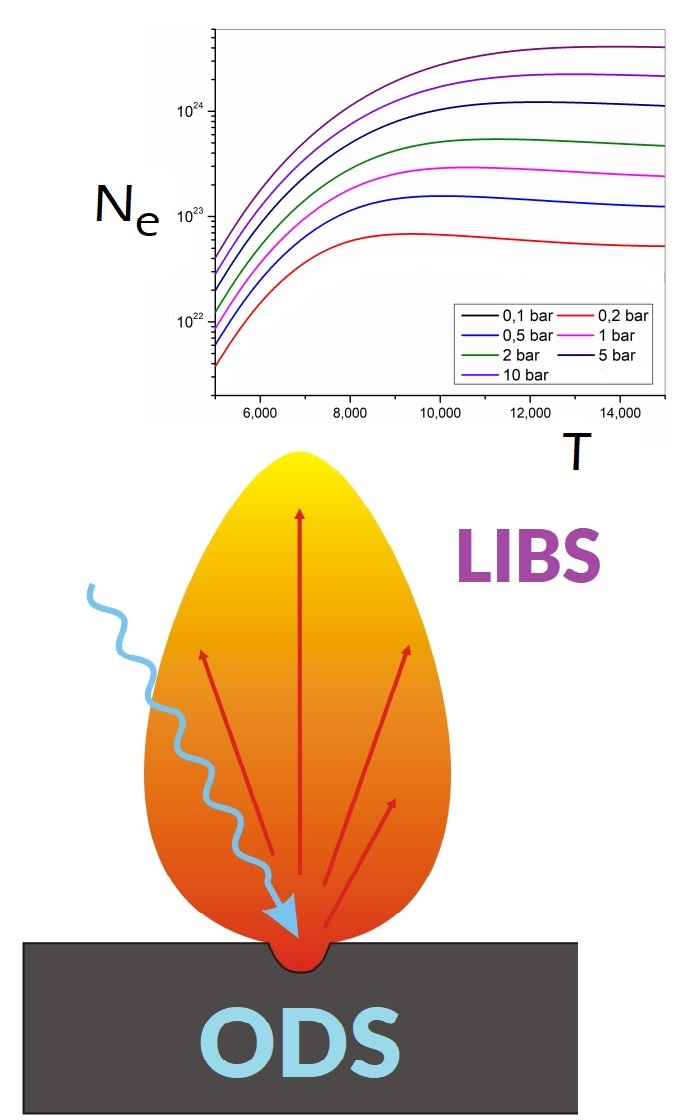Influence of pressure and mixing with air on the equilibrium composition of laser-induced plasma on ODS steel Scientific paper
Main Article Content
Abstract
Laser Induced Plasma (LIP) is transient, the part of the time evolution of its emission used for the Laser Induced Breakdown Spectroscopy (LIBS) technique corresponds to plasma pressures that are comparable to atmospheric, where a certain degree of mixing of the ablated material and air must be taken into account. The aim of this work was to discuss the influence of pressure change and air mixing of laser ablated material on the equilibrium composition of plasma obtained on an ODS steel target, which is a material of great interest for nuclear technology. Special care is devoted to the influence of pressure and mixing on the equilibrium relationship between the temperature T and the electron number density Ne, which is important for plasma diagnostics. The obtained results show that the concept of local thermodynamic equilibrium (LTE) can be used for the LIBS plasma diagnostics and the optimization of spectrochemical analysis parameters. The conclusion refers to the expected interval of plasma pressure during its evolution (10-0.1 bar) and the expected degree of mixing of the ablated material and air, in the temperature range 5,000-15,000 K, relevant for the LIBS technique.
Downloads
Metrics
Article Details

This work is licensed under a Creative Commons Attribution 4.0 International License.

Authors retain copyright and grant the journal right of first publication with the work simultaneously licensed under a Creative Commons Attribution license 4.0 that allows others to share the work with an acknowledgement of the work's authorship and initial publication in this journal.
Funding data
-
Ministarstvo Prosvete, Nauke i Tehnološkog Razvoja
Grant numbers 451-03-137/2025-03/200146;451-03-136/2025-03/200146 -
Science Fund of the Republic of Serbia
Grant numbers 7753287
References
J. Hermann, C. Dutouquet, J. Appl. Phys. 91 (2002) 10188 (https://doi.org/10.1063/1.1479467)
S. V. Shabanov, I. B. Gornushkin, Appl. Phys. A 121 (2015) 1087 (https://doi.org/10.1007/s00339-015-9445-0)
W. B. White, S. M. Johnson, G. B. Dantzing, J. Chem. Phys. 28 (1958) 751 (https://doi.org/10.1063/1.1744264)
J. Radić-Perić, M. Perić, Spectrochim. Acta Part B At. Spectrosc. 35 (1980) 297 (https://doi.org/10.1016/0584-8547(80)80093-0)
D. A. Cremers, L. J. Radziemski, Handbook of Laser-Induced Breakdown Spectroscopy, Second Edition (2013) John Wiley & Sons,
J. Herman, E. Axente, V. Craciun, A. Taleb, F. Pelascini, Spectrochim. Acta Part B At. Spectrosc. 143 (2018) 63 (https://doi.org/10.1016/j.sab.2018.02.015)
E. A. Ershov-Pavlov, K. Yu. Katsalap, K. L. Stepanov, Yu. A. Stankevich, Spectrochim. Acta Part B At. Spectrosc. 63 (2008) 1024 (https://doi.org/10.1016/j.sab.2008.09.009)
C. Cristoforetti, E. Tognoni, L. A. Gizzi, Spectrochim. Acta Part B At. Spectrosc. 90 (2013) 1 (https://doi.org/10.1016/j.sab.2013.09.004)
S. Ukai S, M. Fujiwara, J. Nucl. Mater. 307-311 (2002) 749 (https://doi.org/10.1016/S0022-3115(02)01043-7)
M. Ristić, N. Krstevski, D. Ranković, M. Marković, A. Šajić, M. Kuzmanović, Plasma Phys. Control. Fusion 66 (2024) 125014 (https://doi.org/10.1088/1361-6587/ad8b68)
Kramida A, Ralchenko Y, Reader J and NIST ASD Team, NIST Atomic Spectra Database (version 5.11), National Institute of Standards and Technology, Gaithersburg, MD (2023)
О. П. Семенова, Изв. вузов. Физика. 1 (1958) 95
J. C. Stewart, K. D. Pyatt, Astrophys. J. 144 (1966) 1203 (https://doi.org/10.1086/148714)
O. Ciricosta, S. M. Vinko, H. K. Chung, C. Jackson, R. W. Lee, T. R. Preston, D. S. Rackstraw, J. S. Wark, Phys. Plasmas 23 (2016) 022707 (https://doi.org/10.1063/1.4942540)
M. Lisal , W. R. Smith, M. Bureš, V. Vacek, J. Navratil, Mol. Phys. 100 (2002) 2487 (https://doi.org/10.1080/00268970210130227)
S. M. Pershin, V. N. Lednev, A. F. Bunkin, Phys. Wave Phenom. 19 (2011) 261 (https://doi.org/10.3103/S1541308X11040054).





